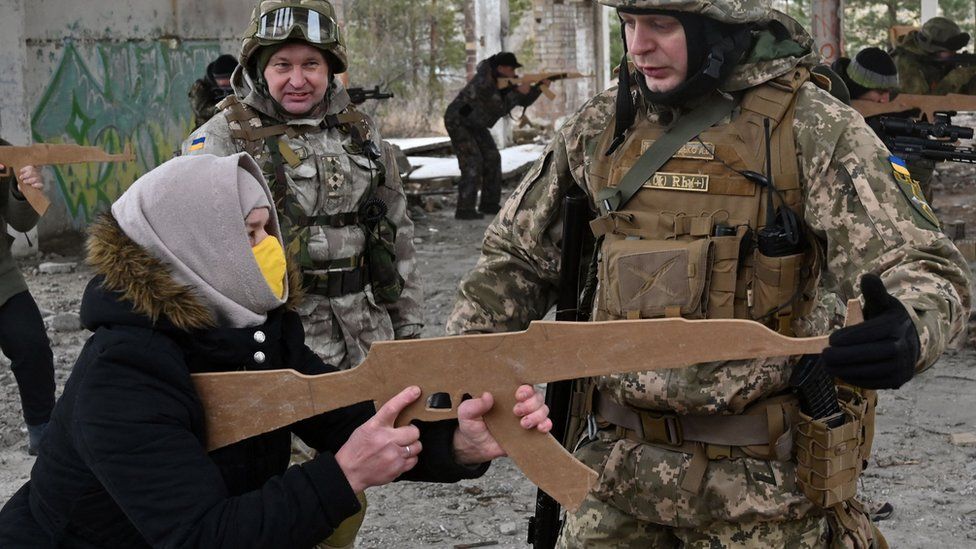The US and UK have been training Ukrainian troops on how to resist a Russian invasion for years. Now a full-scale invasion is under way, there is a debate over how far to support longer-term resistance.
Ukraine’s defence ministry has called on residents to make Molotov cocktails to target incoming Russian troops, and a spirit of resistance is evident among many in the country.
Although it has been wary of any direct military engagement with Russia which could spiral into war, the West has been openly supplying military material – such as anti-tank weapons – to fight an initial invasion.
And more secretly over a period of years, British and US intelligence and special forces have also been training Ukrainian counterparts.
This includes in techniques of so-called irregular or guerrilla warfare, one source told the BBC, likening it to the kind of work undertaken by the Special Operations Executive in World War Two.
Another parallel, they say, is the “stay-behind” plans in the early Cold War, in which secret arms dumps were prepared in the event of Soviet tanks rolling across Europe.
“It’s classic World War Two stuff,” said one person with knowledge of the work. Those plans are now probably being activated to try to slow a Russian advance.
This video can not be played
To play this video you need to enable JavaScript in your browser.
But decisions will also need to be made in London and Washington over how far to go in supporting any longer-term resistance that emerges.When the Soviet Union invaded Afghanistan more than four decades ago, the West supplied weapons and training to Afghan fighters – the Mujahideen – who sought to fight the Red Army through ambushes and attacks.
MI6 teams trekked into Afghanistan to work with commanders. The CIA supplied massive amounts of weaponry, eventually including Stinger missiles, which shot down Soviet gunships.
It took a decade, but eventually Soviet forces were forced to leave. There was a steady toll of casualties, which caused deep disquiet in the Soviet Union, and many believe the defeat contributed to its collapse.
The West also knows what it is like to be on the receiving end, as it became mired in more recent insurgencies in both Afghanistan and Iraq.
There are former military and intelligence officers who openly and strongly advocate supporting resistance in Ukraine.
And when Boris Johnson talks about the need to impose costs on Russia and prove their invasion was not a success, he may not just be talking about the economic cost of sanctions, but also the human cost in the form of the lives of Russian soldiers.

Russia attacks Ukraine: More coverage
- LIVE: Latest updates from on the ground
- THE BASICS: Why is Putin invading Ukraine?
- ZELENSKY: Comedian president rises to the moment
- MAPS: Tracking day four of Russia’s invasion
- IN DEPTH: Full coverage of the conflict

That has made supporting resistance a major topic for debate.
So could something like the Afghan programme happen again? There are a number of things which make it complicated.
One is Russian strategy. Moscow says it does not want an occupation, and that may well be true. It probably understands the risks that this involves and may prefer to install a pliant government. But events could change that calculation.
For a resistance to be effective, it needs a safe haven.
In the 1980s, the Americans and British could use Pakistan as a deniable base of operations. Depending on how events unfold, repeating the feat in Ukraine might require using a neighbouring country which is part of Nato.
The risk would be that Russia could see that as an aggressive move and responds. That could trigger a wider conflict.
It may be different if Russia divides Ukraine in two, though, offering other options.
A related problem is that it is harder to keep things secret, or at least “deniable”. That might have been possible in 1980s Afghanistan, but is a lot harder in 2020s Europe, in which phone cameras and satellites are everywhere.
Russia and its intelligence agencies – particularly the FSB, which has the lead on Ukraine – will also be prepared.
They are already alleged to have drawn up capture-or-kill lists of those who might be involved in any resistance to prevent it developing.
In the early parts of the Cold War, efforts by the CIA and MI6 to back resistance in countries behind the Iron Curtain, such as Ukraine, the Baltics and Albania, all ended in abject disaster. The groups were penetrated by Moscow, which knew exactly what was going on thanks to its spies.
An attempt by the US to train groups to fight in Syria in the last decade also failed.
A “support the resistance” strategy could well be bloody and nasty and Russia has the track record of using brutal methods to suppress such activity – as witnessed in Chechnya. That means the costs may be carried by the people of Ukraine as well as Russia.
Backing a resistance may well be seen as one of the only options available to impose costs on Moscow for its invasion, but Western policymakers will also know it may not be straightforward.





























